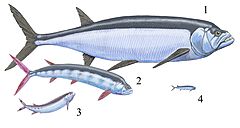Ichthyodectinae
| Ichthyodectidae Temporal range: Late Jurassic-Late Cretaceous 156.0–66 Ma |
|
|---|---|
 |
|
| Scientific classification | |
| Kingdom: | Animalia |
| Phylum: | Chordata |
| Superclass: | Osteichthyes |
| Class: | Actinopterygii |
| Subclass: | Neopterygii |
| Infraclass: | Teleostei |
| Superorder: | Osteoglossomorpha |
| Order: | †Ichthyodectiformes |
| Suborder: | †Ichthyodectoidei |
| Family: |
†Ichthyodectidae Crook, 1892 |
| Subfamilies | |
|
Ichthyodectinae |
|
| Synonyms | |
|
Cladocyclidae |
|
Ichthyodectinae
Saurodontinae
and see text
Cladocyclidae
Unamichthyidae
The family Ichthyodectidae (literally "fish-biters") is an extinct family of marine actinopterygian fish. Sometimes classified in the primitive bony fish order Pachycormiformes, they are now placed in their own order, Ichthyodectiformes, within the superorder Osteoglossomorpha. The type genus is Ichthyodectes, established by Edward Drinker Cope in 1870.
They were most diverse throughout the Cretaceous period, though Thrissops fossils are known from the Oxfordian-Kimmeridgian boundary in the Late Jurassic. Most ichthyodectids ranged between 1 and 5 meters (3–15 ft) in length. All known taxa were predators, feeding on smaller fish; in several cases, larger Ichthyodectidae preyed on smaller members of the family. Some species had remarkably large teeth, though others, such as Gillicus arcuatus, had small ones and sucked in their prey.
The basal phylogeny is very badly resolved, leading to many ichthyodectids that are simply known to be rather primitive, but where nothing certain can be said about their precise relationships.
...
Wikipedia
